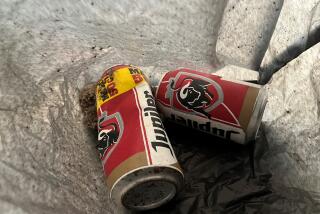ARTIST SERIOUS ABOUT FROTHY WORK
- Share via
Two hundred and sixteen bottles of beer went up on a wall at the Newport Harbor Art Museum on Friday.
But the bottles are not meant to slake anyone’s thirst. They’re part of a recently acquired sculpture titled “An Aid to Communication,” by San Francisco conceptual artist Tom Marioni.
“There’s a tongue-in-cheek aspect to it, but it’s also meant to be taken seriously,” Marioni said after the work’s installation.
The sculpture consists of bottles of Anchor Steam beer arranged in eight rows on wooden shelves. The number is not important, Marioni said, but the brand is.
“The beer is made in San Francisco and is a very rich, very good product, almost like an artist would make.”
The sculpture grew out of a series of works documenting beer--drinking as a kind of ritual.
In one of these--”The Museum of Conceptual Art at the San Francisco Museum of Modern Art” --museum visitors drank free beer available in a refrigerator in the gallery and gradually filled up six shelves with the emptied bottles.
In many cases, these works document Marioni’s drinking beer with his friends and discussing art. “I have very romantic notions of artists drinking and talking in cafes,” he said.
“But all cafes filled with people drinking beer are not works of art. It’s not art until it’s documented or announced or given a title or framed.”
Marioni’s sculpture was designed to be exhibited under yellow light, according to the artist. “Yellow light creates a warm atmosphere and gives it a glow. It’s important to see in that light because the main thing for the viewer is to experience a mood.”
Paul Schimmel, chief curator at the museum, said he considers the work “more than an object in itself.”
“It represents a remarkable compression of the conceptual and social art activity by many Bay Area artists during the ‘60s by one of its leading participants. This is really a symbol of that period and its lively interaction between artists, their peers and critics.”
Schimmel declined to disclose the cost of the acquisition, but said: “I believe the value which the artist assigned to the piece and what we paid is substantially less than the value it has in representing an era.”
More to Read
The biggest entertainment stories
Get our big stories about Hollywood, film, television, music, arts, culture and more right in your inbox as soon as they publish.
You may occasionally receive promotional content from the Los Angeles Times.










